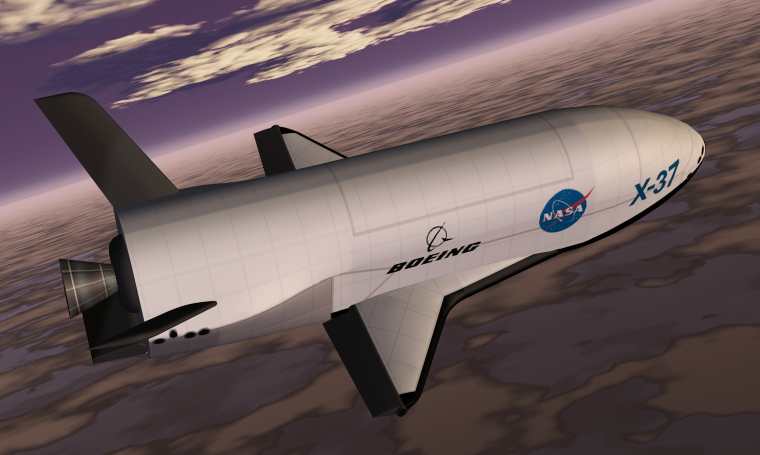The U.S. Space Force, in partnership with the Air Force Rapid Capabilities Office, is preparing to launch the eighth mission of the enigmatic X37-B Orbital Test Vehicle (OTV) spaceplane with a payload that includes next-generation communications lasers that can support or replace other communications methods, and a quantum inertial sensor designed to offer navigation capabilities in GPS-denied environments.
Scheduled to achieve orbit aboard a SpaceX Falcon 9 rocket from Kennedy Space Center, Florida on Aug. 21, 2025, the mission, dubbed OTV-8, is the latest effort by the Space Force, the Air Force Research Lab and the Defense Innovation Unit, to prepare for potential attacks on systems like GPS and communications satellites that play a critical role in defense strategies.
Next Generation Lasers Aboard X37-b Critical to Long-Term Space Force Goals
According to a statement from the Secretary of the Air Force Public Affairs announcing the mission, the next generation communication lasers carried aboard the X-37B will be part of a larger effort to improve the “resilience, efficiency, and security of U.S. space based communications architectures” by demonstrating the viability of in-space laser communications. This will include testing the concept of proliferated commercial satellite networks in Low Earth Orbit with infrared lasers.
“Laser communications are integral to the future of space communications as the shorter wavelength of infrared light increases the amount of data that can be sent with each transmission,” the statement explains.
The concept of laser communication in space is also more secure than traditional forms of communication due to the line-of-sight nature of lasers, which limits who can receive them. The Space Force said proliferated communications networks using laser-based satellite communication improve the security and resilience of the country’s space assets “by ensuring that they contain no single point of failure.”
 The X37-B Orbital Test Vehicle (OTV). Image credit: U.S. Space Force.
The X37-B Orbital Test Vehicle (OTV). Image credit: U.S. Space Force.
“OTV-8’s laser communications demonstration will mark an important step in the U.S. Space Force’s ability to leverage proliferated space networks as part of a diversified and redundant space architectures. In so doing, it will strengthen the resilience, reliability, adaptability, and data transport speeds of our satellite communications architecture,” explained Gen. Chance Saltzman, Chief of Space Operations.
Quantum Inertial Sensors Can Ensure Navigation Even Without GPS
Along with lasers, the upcoming X37-B mission will carry what the statement described as “the world’s highest performing quantum inertial sensor ever used in space.” Unlike Global Positioning Systems that use satellite communication to establish a location on or near Earth, the concept of quantum inertial navigation requires the ability to detect the rotation and acceleration of atoms.
When measured accurately, this process can enable unaided navigation in space. The Space Force’s statement said this type of technology can restore coordinated force navigation “in GPS-denied environments,” which would “enhance the navigational resilience of U.S. spacecraft in the face of current and emerging threats.”
Because a quantum inertial sensor that can offer accurate speed and coordinates without the satellite network and other components needed for reliable GPS navigation, it could offer a previously unavailable tool for deep space missions to the Moon and beyond. The Space Force said that due to this capability, they “promise to push the technological frontiers of long-distance space travel and exploration.”
“OTV 8’s quantum inertial sensor demonstration is a welcome step forward for operational resilience in space,” explained Col. Ramsey Horn, Space Delta 9 commander. “Whether navigating beyond Earth-based orbits in cislunar space or operating in GPS-denied environments, quantum inertial sensing allows for robust navigation capabilities when GPS navigation is not possible.”
“Ultimately, this technology contributes significantly to our thrust within the Fifth Space Operations Squadron and across the Space Force, guaranteeing movement and maneuverability even in GPS-denied environments,” the Colonel added.
Christopher Plain is a Science Fiction and Fantasy novelist and Head Science Writer at The Debrief. Follow and connect with him on X, learn about his books at plainfiction.com, or email him directly at christopher@thedebrief.org.

